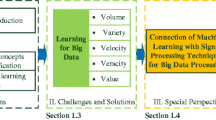Abstract
The rapid development of mobile Internet triggered massive data exchange among multiple sources, which then results in challenges in the efficiency of multi-user data transmission. Spatial coupling multiple access, where different users share the same resource blocks by superimposing data streams with different time offsets, has been proposed to obtain higher spectral efficiency. The optimization of the system can be carried out through for example constellation rotation or power allocation, which mitigates the interferences and distinguishes users/data streams better. The optimization aims for the maximization of the average mutual information between the transmitted data symbols and the received signal. To solve the optimization problem, we employ machine learning based methods to locate the possibly global optimal solution. Simulation results show that the optimization clearly contributes to the performance improvement of the system.








Similar content being viewed by others
References
Dai, L., Wang, B., Yuan, Y., Han, S., I, C. l, & Wang, Z. (2015). Non-orthogonal multiple access for 5G: Solutions, challenges, opportunities, and future research trends. IEEE Communications Magazine, 53(9), 74–81.
Yan, C., Harada, A., Benjebbour, A., Lan, Y., Li, A., & Jiang, H., et al. (2015). Receiver design for downlink non-orthogonal multiple access (NOMA), 2015 IEEE 81st vehicular technology conference (VTC Spring), Glasgow, pp. 1–6.
Nikopour, H., & Baligh, H. (Sep 2013). Sparse code multiple access. In 2013 IEEE 24th international symposium on personal, indoor and mobile radio communications (PIMRC), London, UK, pp. 332–336.
Chen, S., Ren, B., Gao, Q., Kang, S., Sun, S., & Niu, K. (2017). Pattern division multiple access—A novel nonorthogonal multiple access for fifth-generation radio networks. IEEE Transactions on Vehicular Technology, 66(4), 3185–3196.
Hojeij, M. R., Farah, J., Nour, C. A., & Douillard, C. (2015). Resource allocation in downlink non-orthogonal multiple access (NOMA) for Future Radio Access. In 2015 IEEE 81st vehicular technology conference (VTC Spring), Glasgow, pp. 1–6.
Truhachev, D., Lentmaier, M., & Zigangirov, K. S. (2001). Mathematical analysis of iterative decoding of LDPC convolutional codes. In Proceedings of 2001 IEEE international symposium on information theory, Washington, DC, pp. 191.
Lentmaier, M., Sridharan, A., Costello, D. J., & Zigangirov, K. S. (2010). Iterative decoding threshold analysis for LDPC convolutional codes. IEEE Transactions on Information Theory, 56(10), 5274–5289.
Truhachev, D. (2013). Universal multiple access via spatially coupling data transmission. In 2013 IEEE international symposium on information theory, Istanbul, pp. 1884–1888.
Zhang, R., & Hanzo, L. (2011). A unified treatment of superposition coding aided communications: Theory and practice. In IEEE Communications Surveys & Tutorials (Vol. 13, no. 3, pp. 503–520), Third Quarter 2011.
Si, Z., & Jiang, M. (2017). Improved spatially-coupled multiuser transmission via constellation rotation. In 2017 IEEE 28th annual international symposium on personal, indoor, and mobile radio communications (PIMRC)–workshop on new radio technologies, Montreal.
Sharfer, I., & Hero, A. O. (1999). A maximum likelihood digital receiver using coordinate ascent and the discrete wavelet transform. IEEE Transactions on Signal Processing, 47(3), 813–825.
Hosein, P., & Wu, Tao. (2008). Coordinate ascent scheduler for the multi-user MIMO uplink channel. In 2008 IEEE 19th international symposium on personal, indoor and mobile radio communications, Cannes, pp. 1–5.
Wang, T., & Vandendorpe, L. (2010). Coordinate ascent based resource allocation algorithm for maximizing WSMR in downlink cellular OFDMA systems. In 2010 IEEE 21st International symposium on personal, indoor and mobile radio communications workshops, Instanbul, pp. 381-386.
Sotthivirat, S., & Fessler, J. A. (2002). Image recovery using partitioned-separable paraboloidal surrogate coordinate ascent algorithms. IEEE Transactions on Image Processing, 11(3), 306–317.
Goldberg, D. E. (1989). Genetic algorithms in search, optimization and machine learning. Boston, MA: Addison-Wesley Publishing Company Inc.
Iba, K. (1994). Reactive power optimization by genetic algorithm. IEEE Transactions on Power Systems, 9(2), 685–692.
Lee, K. Y., Bai, Xiaomin, & Park, Young-Moon. (1995). Optimization method for reactive power planning by using a modified simple genetic algorithm. IEEE Transactions on Power Systems, 10(4), 1843–1850.
Lee, K. Y., & Yang, F. F. (1998). Optimal reactive power planning using evolutionary algorithms: A comparative study for evolutionary programming, evolutionary strategy, genetic algorithm, and linear programming. IEEE Transactions on Power Systems, 13(1), 101–108.
Yen, Kai, & Hanzo, L. (2001). Genetic algorithm assisted joint multiuser symbol detection and fading channel estimation for synchronous CDMA systems. IEEE Journal on Selected Areas in Communications, 19(6), 985–998.
Hou, E. S. H., Ansari, N., & Ren, Hong. (1994). A genetic algorithm for multiprocessor scheduling. IEEE Transactions on Parallel and Distributed Systems, 5(2), 113–120.
Takeuchi, K., Tanaka, T., & Kawabata, T. (2015). Performance improvement of iterative multiuser detection for large sparsely spread CDMA systems by spatial coupling. IEEE Transactions on Information Theory, 61(4), 1768–1794.
Author information
Authors and Affiliations
Corresponding author
Additional information
Publisher’s Note
Springer Nature remains neutral with regard to jurisdictional claims in published maps and institutional affiliations.
The material in this paper was presented in part at the IEEE International Symposium on Personal, Indoor and Mobile Radio Communications (PIMRC) - Workshop on New Radio Technologies, Montreal, Canada, October 2017.
Rights and permissions
About this article
Cite this article
Si, Z., Jiang, M. & Jiang, L. Optimization of Spatially-Coupled Multiuser Data Transmission Through Machine Learning Methods. Wireless Pers Commun 102, 2345–2362 (2018). https://doi.org/10.1007/s11277-018-5910-3
Published:
Issue Date:
DOI: https://doi.org/10.1007/s11277-018-5910-3




